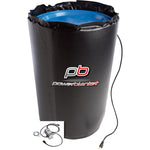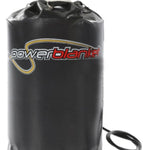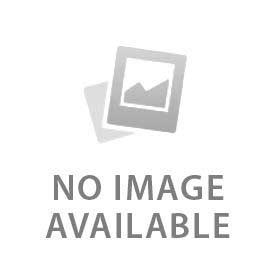You have no items in your shopping cart.
Article At-a-Glance
What Are Industrial Heating Elements and How Do They Work?
Industrial heating elements are devices that convert electrical energy into heat to maintain precise temperatures in various industrial applications, with options like flanged, screwplug, over-the-side, immersion, and circulation heaters, each offering unique benefits and material choices to suit specific process needs.
Key Takeaways
- Understand the Basics: Industrial heating elements convert electrical energy into heat, crucial for maintaining precise temperatures in various industrial processes. They are made from materials like nickel, chromium, and titanium to withstand high temperatures.
- Explore Different Types: Key types include flanged, screwplug, over-the-side, immersion, and circulation heaters, each offering unique benefits such as ease of installation, thermal efficiency, and safety features.
- Application-Specific Choices: Selecting the right heating element depends on the specific industrial application, such as chemical processing, food production, or pharmaceuticals, where factors like thermal efficiency and safety are paramount.
- Material Considerations: Choosing the appropriate material for heating elements is essential, especially when dealing with corrosive substances, to ensure durability and performance.
- Consult Experts for Custom Solutions: For optimal results, consult with experts to tailor heating element choices to your specific industrial needs, considering factors like cost, efficiency, and safety.
Different Types of Heating Elements
There are various electric heating elements available on the market today, each with its own set of benefits and drawbacks. It's important to choose the right one for your specific industrial process needs to maximize efficiency and minimize downtime. In this blog post, we'll discuss some of the most popular heating elements, including flanged, screwplug, over-the-side, immersion heaters, circulation heaters, and more.
Each of these options drives us into the future as they turn electrical energy into heat and help you maintain a constant temperature for whatever liquid, fluid, gas, or other material you need to control.
Each heating element is made of metals and alloys that can withstand high temperatures. Some common materials used include nickel, chromium, and titanium. To achieve the desired results, select the right heating element material for your specific process needs. For example, if you're working with a corrosive material, you'll need to choose a metal resistant to corrosion.

Flanged Heaters
Flanged heaters are one of the most popular types of heating elements. They're designed for easy installation and can be used in many applications. One of the main benefits of flanged heaters is that they offer a high degree of flexibility with how you can position them. They can be easily removed and replaced if necessary. A drawback to flanged heaters is they also take up more space and can be more difficult to install.
Screwplug Heaters
Similar to flanged heaters, screwplug heaters are designed for easy installation and can be used in a variety of applications. One of the main benefits of screwplug heaters is that they offer a high degree of flexibility in positioning and allow for quick application. They allow for rapid heating and can be easily removed and replaced if necessary.
Over-the-Side Heaters
Over-the-side heaters are heating elements designed to be installed over the side of an industrial tank or vessel. They can be placed over the side of many different sizes of tanks or vessels. One of the main benefits of over-the-side heaters is that they offer a higher degree of thermal efficiency than other heating elements because they apply direct heating as they come into contact with the material and are more efficient with their heat energy. They can also be more expensive, however, and they may not be suitable for all applications.
Immersion Heaters
Immersion heaters are electric heating elements designed to be submerged in liquids. They allow you to avoid surface heating and heat the liquid from within the tank or vessel to give you more control over the operating temperature. As they offer a high degree of thermal efficiency for fluid heating, they can improve efficiency for many industrial heating options. An important benefit of immersion heaters is that they're less likely to cause fires or explosions than other heating elements.

$484.00 USD
1" NPT Screwplug Heater w/ Thermostat - Brass Plug Copper Element (2000W, 120V)
Circulation Heaters
Circulation heaters are electric heating elements designed to circulate liquids or gases. Thermal efficiency is important in many applications, and these products can provide a high degree of thermal efficiency. One of the main benefits of circulation heaters is that they're less likely to cause fires or explosions than other heating elements, which can be extremely beneficial for industries with hazardous areas. They also allow more uniform temperature distribution for products which saves energy and is most cost-effective.
What Industries Use These Elements
The different electric heating elements discussed in this blog post can be used across a multitude of industries, including chemical processing, petrochemical processing, food processing, pharmaceuticals, and more. It's important to consider the specific needs and requirements of your industry when choosing the right electric heating element for your industrial process.
For example, immersion heaters are commonly used in the food industry because they heat the liquid from within the tank or vessel, as opposed to just heating the surface. Whereas an example of how pharmaceutical might use an electric heating element is in the production of vaccines. Vaccines must be stored at a specific temperature to maintain their efficacy, and immersion heaters can help keep tanks or vessels at the correct temperature. Creating this temperature uniformity prevents the product from reaching high temperatures that could ruin the vaccine.

Choosing the Right Heating Element
If you are ready to make a choice and start to generate heat for your industrial process needs, it's important to consider factors such as application, installation requirements, thermal efficiency, and safety. Consulting with a trusted expert in electric heating elements can also help determine the right choice for your specific needs so you can maximize heater output.
There are many electric heating element options available on the market today, each with its own set of benefits and drawbacks. As you choose the right electric heating element for your industrial process, consider factors such as cost, efficiency, ease of installation and maintenance, safety risks, and compatibility. We hope this information has shed some light on which heating element is right for you.













